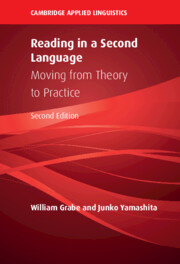Book contents
- Reading in a Second Language
- The Cambridge Applied Linguistics Series
- Reading in a Second Language
- Copyright page
- Dedication
- Contents
- Figures
- Tables
- Preface
- Part I Foundations of Reading
- 1 The Nature of Reading: Defining Reading
- 2 How Reading Works: The Building Blocks of Fluency and Comprehension
- 3 How Reading Works: Comprehension Processes
- 4 Cognitive Issues in Reading
- 5 Neurocognitive Processing and Reading Ability
- 6 Explaining Reading Comprehension: Models of Reading
- Part II Patterns of Variation in Reading
- Part III Developing Reading Comprehension Abilities
- Part IV Expanding Reading Comprehension Skills
- Part V Applications of Reading Research: Instruction and Assessment
- References
- Author Index
- Subject Index
3 - How Reading Works: Comprehension Processes
from Part I - Foundations of Reading
Published online by Cambridge University Press: 01 September 2022
- Reading in a Second Language
- The Cambridge Applied Linguistics Series
- Reading in a Second Language
- Copyright page
- Dedication
- Contents
- Figures
- Tables
- Preface
- Part I Foundations of Reading
- 1 The Nature of Reading: Defining Reading
- 2 How Reading Works: The Building Blocks of Fluency and Comprehension
- 3 How Reading Works: Comprehension Processes
- 4 Cognitive Issues in Reading
- 5 Neurocognitive Processing and Reading Ability
- 6 Explaining Reading Comprehension: Models of Reading
- Part II Patterns of Variation in Reading
- Part III Developing Reading Comprehension Abilities
- Part IV Expanding Reading Comprehension Skills
- Part V Applications of Reading Research: Instruction and Assessment
- References
- Author Index
- Subject Index
Summary
Chapter 3: Comprehension Processes. This chapter describes higher-level processes and how both lower- and higher-level processes work together to form a mental text representation and a situation model of reading. Key features of higher-level processing include the following: text representation, situation model processing skills associated with working memory, background knowledge, and executive function resources. Key concepts include passive resonance processing, bridging inferences, the now-or-never bottleneck, lexical processing, incremental item-based learning, Kintsch’s Construction-Integration model of reading, a two-level account of reading comprehension, genre variations in text processing, working memory as executive function, other executive functions, attentional processing, inferencing, metacognitive and metalinguistic awareness, strategy use, goal setting, and comprehension monitoring. The chapter concludes with implications for instruction.
Keywords
- Type
- Chapter
- Information
- Reading in a Second LanguageMoving from Theory to Practice, pp. 55 - 83Publisher: Cambridge University PressPrint publication year: 2022

